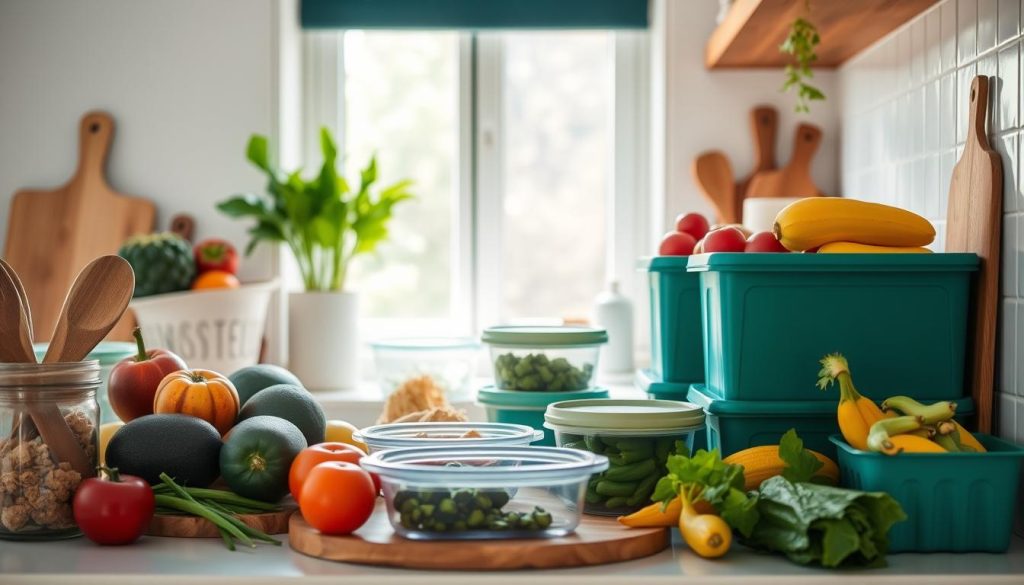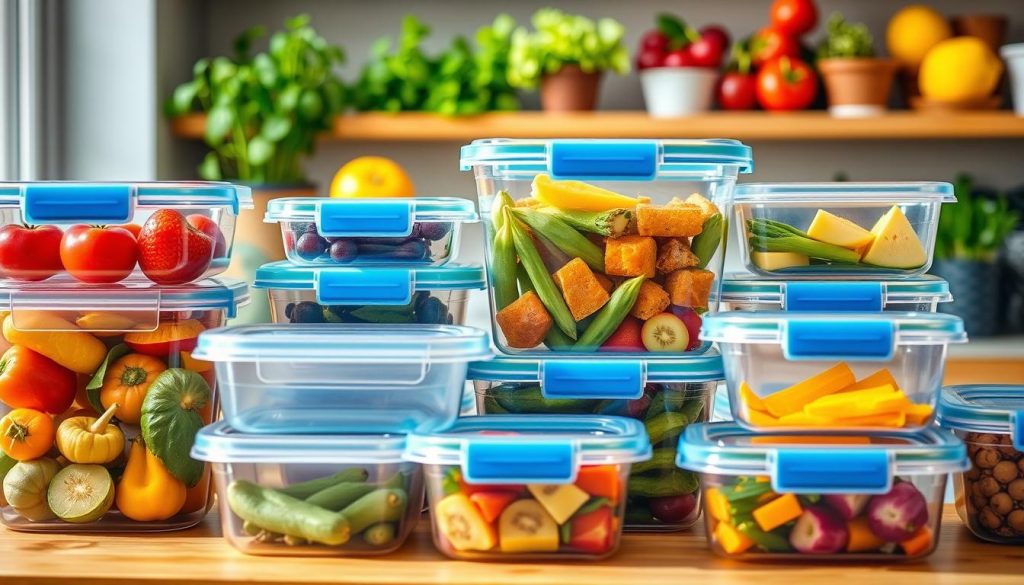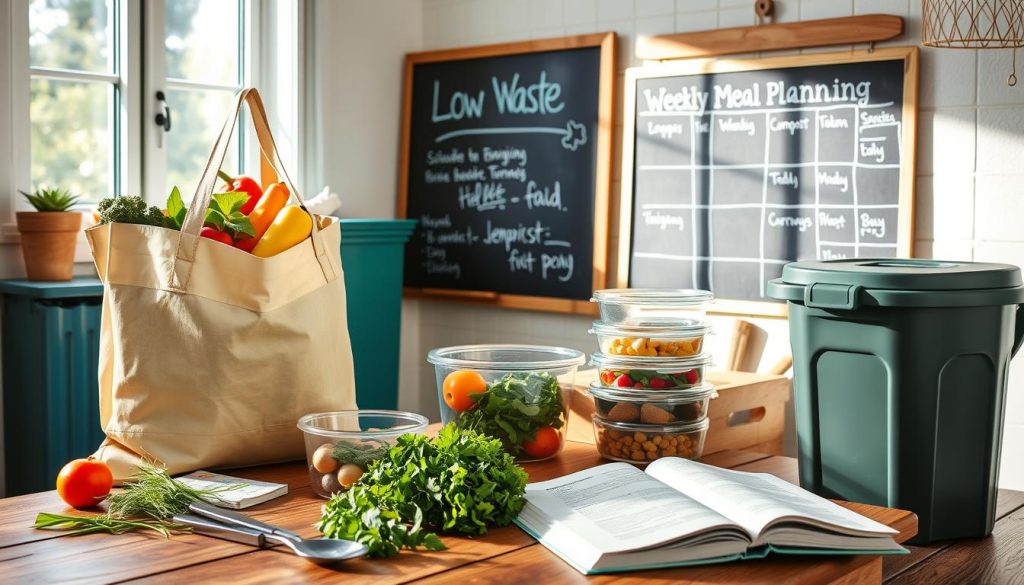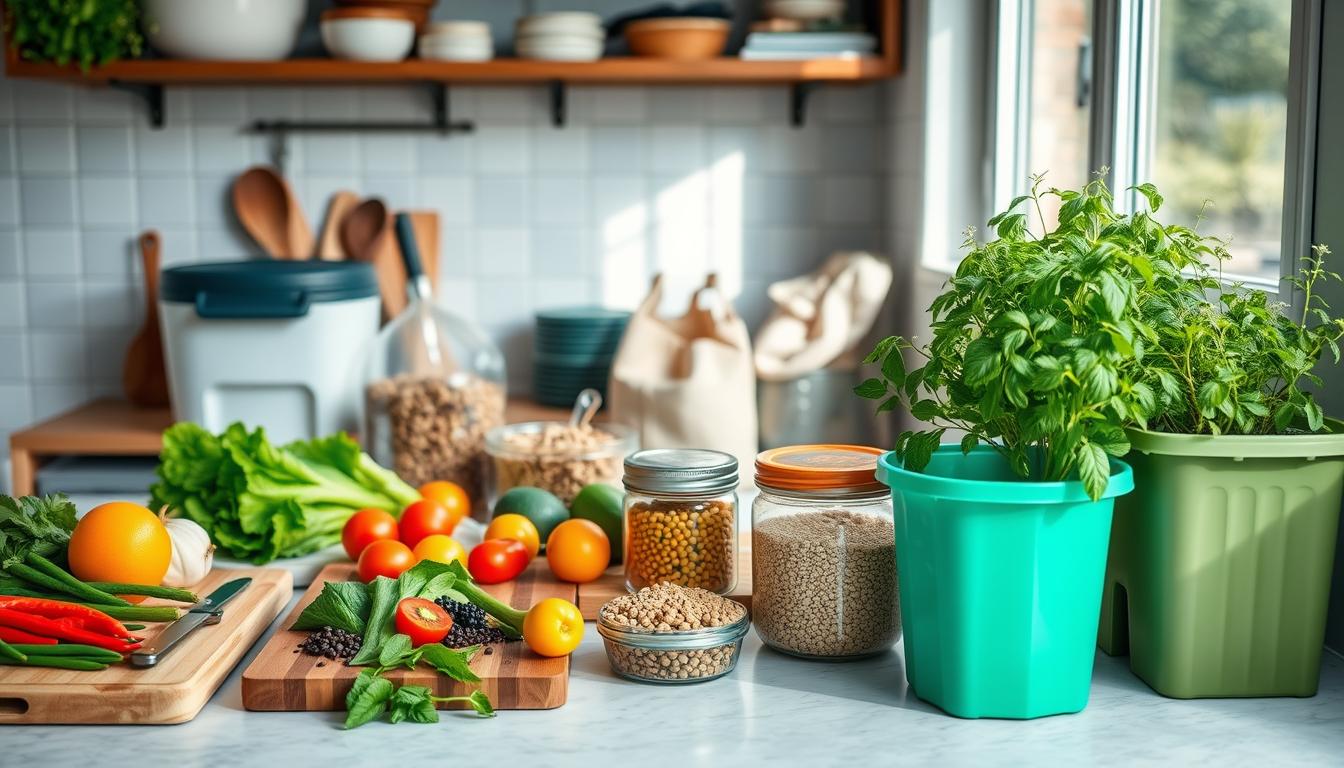In today’s world, cooking in a sustainable way is key. Low-waste meal planning helps us save money and protect our planet. It lets us make smart choices in the kitchen, reducing waste and saving cash.
Low-waste meal planning is all about being green and practical. Making a few tweaks in our cooking can greatly help the environment and our wallets. These small changes can make a big difference in our efforts to live more responsibly.
Join me as we explore the best ways to adopt this eco-friendly approach. Discover the many benefits of choosing a low-waste lifestyle.
Understanding Low-Waste Meal Planning
Low-waste meal planning is more than a trend. It’s a choice to reduce food waste. By following its principles, we can help our planet.
What is Low-Waste Meal Planning?
It’s about planning meals to cut down on waste. We use every part of ingredients and avoid single-use packaging. Choosing ingredients wisely and planning portions are key.
Benefits of Low-Waste Meal Planning
It has many benefits. It reduces our carbon footprint by using local ingredients. This saves money and promotes healthy eating.
How It Differs from Traditional Meal Planning
It focuses on sustainability, not just convenience. We pick ingredients to waste less and use leftovers in creative ways. It also supports local farmers and healthier food choices.
Getting Started with Low-Waste Meal Planning

Starting a low-waste meal planning journey can seem daunting. But, taking small steps can make it easier. Begin by checking how much food you waste and setting goals to reduce it.
Assessing My Current Food Waste
Understanding your current food waste is the first step. Keep a log of all food you throw away for a week. Write down what you threw away, how much, and why. This helps spot patterns and areas to improve.
- Use a dedicated waste logbook or app for tracking.
- Separate food categories: perishables, leftovers, and expired items.
- Reflect on portion sizes and meal prep habits contributing to waste.
Setting Personal Goals for Waste Reduction
After checking your food waste, set realistic goals to reduce it. Making your goals personal helps you stick to them. Here are some tips for reducing waste in your cooking:
- Plan meals around what you already have in your pantry and fridge.
- Buy only what you need, avoiding impulse buys and bulk purchases.
- Incorporate leftovers into new dishes instead of discarding them.
- Use storage methods that extend the freshness of ingredients.
Staying motivated is crucial. Remember, reducing waste helps the environment and makes your cooking healthier. Celebrating small victories can keep you going.
| Goal | Actions | Benefits |
|---|---|---|
| Reduce food waste by 30% in 1 month | Track food waste weekly, adjust portions, use leftovers | Lower food costs, less environmental impact |
| Incorporate 1 new low-waste recipe per week | Choose recipes that use whole ingredients and minimal packaging | More variety in meals, reduce waste |
Strategies for Successful Low-Waste Meal Planning
Starting a low-waste meal planning journey can seem daunting. But, with the right strategies, it becomes a fulfilling change. By adopting sustainable kitchen habits, I cut down on food waste, save money, and support local farmers. Here are some key strategies that work well for me.
Focusing on Seasonal and Local Ingredients
Choosing seasonal and local ingredients is a great way to reduce waste. This produce is fresher, tastes better, and is often cheaper. It also helps local farmers and cuts down on carbon emissions from food transport.
Utilizing Leftovers Creatively
Turning leftovers into new meals is a key part of sustainable cooking. I use leftover veggies in soups or casseroles. Stale bread becomes croutons or bread pudding. This way, I make sure to use every bit of what I buy, reducing waste.
Batch Cooking and Freezing
Batch cooking and freezing meals is another effective strategy. It saves time and resources and helps prevent food from spoiling. Freezing meals also helps me stick to my meal plans, avoiding takeout that can lead to more waste.
Here’s a quick comparison of the benefits of adopting these sustainable kitchen habits:
| Strategy | Benefits |
|---|---|
| Focusing on Seasonal and Local Ingredients | Fresher produce, support for local farmers, reduced carbon footprint |
| Utilizing Leftovers Creatively | Reduced food waste, inventive meals, cost savings |
| Batch Cooking and Freezing | Time efficiency, less spoilage, convenient meal options |
The Role of Proper Food Storage

Proper food storage is key for sustainable cooking and eco-friendly meal prep. It keeps food fresh and reduces waste. Knowing how to store food, using the right containers, and understanding expiration dates helps make a kitchen more sustainable.
Best Practices for Food Storage
Keeping food fresh is crucial for sustainable cooking. Here are some tips for storing different foods:
- Store fruits and vegetables in the crisper drawer to maintain humidity.
- Keep herbs fresh by storing them in a jar with a small amount of water, like a bouquet.
- Store dry foods such as grains, pasta, and legumes in airtight containers.
- Monitor refrigerator temperature to ensure it stays below 40°F (4°C).
Using Containers to Extend Freshness
Airtight containers are essential for eco-friendly meal prep. They help keep food fresh longer and reduce waste. Here’s how:
- Use glass or BPA-free plastic containers for leftovers and meal prep.
- Utilize vacuum-sealed bags for marinating and preserving meats.
- Consider silicone bags for storing snacks and produce.
- Ensure containers are properly sealed to maintain freshness and prevent spills.
Understanding Expiration Dates
Knowing expiration dates is crucial for reducing waste and sustainable cooking. Not all dates mean the same thing:
- Sell-by: This date is for stores to know when to stop selling the product. It doesn’t mean the food is bad after this date.
- Best-by: Shows when the product is at its best quality. It’s still safe to eat after this date, but might not taste as good.
- Use-by: This is when the product is at its peak quality. After this date, it might still be safe but not as good.
By understanding these dates, I can make better choices about food safety and quality. This helps reduce waste.
Meal Planning Tools and Resources

To plan meals without waste, the right tools are key. There are many digital and manual aids to help. Let’s look at some top picks for low-waste meal planning.
Apps That Support Low-Waste Meal Planning
Using apps for meal planning can make it easier. Many apps are made to help reduce waste:
- Mealime: This app creates waste-free meal plans with simple recipes. It also makes shopping lists to avoid buying too much.
- Too Good To Go: This app lets you buy surplus food at a lower price. It helps cut down on waste and offers new meal ideas.
- Paprika Recipe Manager: Paprika lets you add recipes, plan meals, and make shopping lists. It ensures you use every ingredient.
Weekly Planning Sheets to Stay Organized
For those who like a hands-on approach, weekly planning sheets are great. They help plan meals, track ingredients, and use leftovers wisely. Here are some good options:
- Printable Meal Planner Sheets: These sheets can be customized and downloaded. They fit different schedules and help keep track of meals and leftovers.
- Bullet Journal Method: Using a bullet journal is a flexible and creative way to plan meals, make shopping lists, and track waste reduction.
- Dry-Erase Boards: These boards are easy to change and reuse. They let you plan meals for the week and adjust plans to avoid waste.
Using these tools and resources makes it easier to plan meals without waste. A mix of digital and manual methods makes sustainable eating practical and fun.
Recipes for Low-Waste Meal Planning
Adopting zero-waste recipes and green meal planning makes our kitchens more sustainable. By taking a few smart steps, we can cut down on food waste and still enjoy tasty meals.
Simple Recipes That Minimize Waste
Starting with versatile ingredients is key to making meals that waste less. Here are some easy zero-waste recipes:
- Vegetable Stir-Fry: A fantastic way to use up any leftover veggies. Just sauté them with garlic, ginger, and soy sauce. Serve over rice or noodles.
- Leftover Soup: Mix leftover grains, proteins, and veggies in a broth. Add your favorite herbs and spices for a cozy meal.
- Fruit Smoothies: Use ripe fruit to make tasty smoothies. Blend with yogurt, milk, or a non-dairy option for a healthy drink.
Tips for Repurposing Ingredients
Repurposing ingredients is crucial for green meal planning and sustainable kitchens. Here are my best tips:
- Make a tasty broth from veggie scraps by simmering them in water and spices.
- Use old bread to make croutons or bread pudding, cutting down on waste.
- Freeze leftover herbs in ice cube trays with olive oil for future cooking.
- Turn cooked grains like rice or quinoa into salads or fried rice.
- Use citrus peels as zest or to infuse water for a refreshing drink.
By following these tips, we can make our kitchens both resourceful and sustainable. This aligns perfectly with the goals of zero-waste recipes and green meal planning.
Overcoming Challenges in Low-Waste Meal Planning
Starting a low-waste meal planning lifestyle can be tough. Time constraints and keeping meals interesting are common hurdles. I’ve faced these challenges and found ways to keep going.
Common Obstacles and How I Tackle Them
Time is a big challenge. Work and family leave little time for meal planning. I solve this by setting aside one day a week for meal prep. This saves time and helps avoid waste.
Another issue is feeling like meals are too repetitive. To fix this, I try new ingredients and recipes. Visiting farmers’ markets and finding new recipes keeps my meals fresh and supports my low-waste goals.
Staying Motivated on My Low-Waste Journey
Motivation is key for any lifestyle change. I track my waste reduction to stay motivated. Online communities and eco-conscious influencers also inspire me.
I focus on making small, achievable changes. Every little bit helps. Celebrating small wins keeps me excited about my low-waste journey.
Low-waste meal planning is a journey of learning. By facing challenges head-on, I stay committed to reducing waste. I hope to inspire others to make a difference too.
